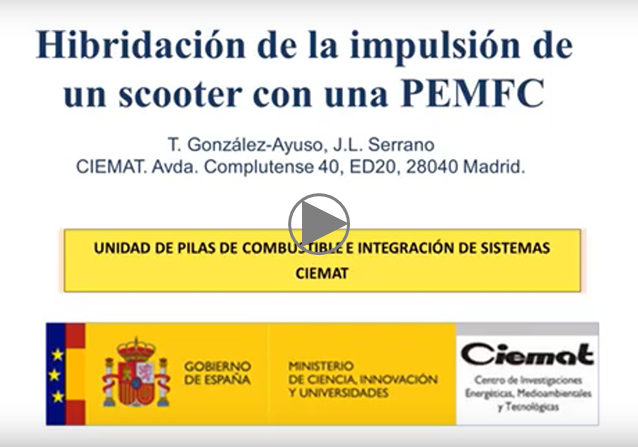Activities of System Integration Group
Systems integration group works in the development of fuel cell applications and the integration of fuel cells into integrated systems for the generation of electric power. It is made by a researcher (PhD), two engineers and support staff and training. Developed projects are related to applications portable or stationary (development of a processor of fuel with a built-in fuel cell), applications to the transport (integration of a fuel cell in small vehicles), and to development of a system of uninterruptible power supply with fuel cell.. More info (contact).
Trigeneration with Geotermia, Hydrogen and Renewable Energy (TOGETHER)
 TrigeneratiOn with GEoTermia, Hydrogen and Renewable Energy
TrigeneratiOn with GEoTermia, Hydrogen and Renewable Energy
Call for proposal: Retos-Colaboración 2017, Programa Estatal de Investigación, Desarrollo e Innovación Orientada a los Retos de la Sociedad. Plan Estatal de Investigación Científica y Técnica y de Innovación 2013-2016.
Funding: Ministry of Science, Innovation and Universities. Co-funding by The European Regional Development Fund - European Union
ID Number: RTC-2017-5926-3.
Keywords: cogeneration, micro-CHP, energy efficiency, geotermia, hydrogen, electrolyzer
Project Objectives: The present project Trigeneración with GEoTermia, Hydrogen and Renewable Energies (TOGETHER) will seek to improve energy efficiency in air conditioning,
generation of ACS and electricity supply through the technological development and research of a versatile and modular system that includes the fields of power generation, storage, and use, based on the combination of EE.RR. and of the H2 cycle in heat and cold cogeneration systems with geothermal and absorption machines.
The developments of the project will be studied in two laboratories with different working conditions (system components and modes of operation) and the global system in a living-lab, under real conditions of use. At the same time, systems will be developed for the direct use of the H2 generated in the equipment destined to the generation of ACS, heating and cooling in order to improve their performance.
The project will be divided into 3 main parts, intimately linked among them:
- Production of electrical energy by means of EE.RR. that either it will be stored in batteries or it will be used to obtain H2.
- Integration of the production cycle of H2 in a commercial module and optimization of the use of energy: H2 generation and H2 storage and its subsequent use by fuel cell in different stationary applications in isolated systems and connected to the grid.
- Applications of Generation, Cogeneration or Trigeneration.
The system will be developed in such a way that it can be part of a distributed generation network or as a single supply. The Generation will focus on the optimization of a module that will be able to cover the energy demand expected for the system and with the storage capacity of the energy generated electrochemically with batteries and with storage of H2 through the use of an electrolyser powered by energy. photovoltaic and minieólica to produce a flow of H2 such that allows the maximum energy use. The integration of the system in a commercial module will cover the storage requirements of the H2, for the moments in which the generation can not be carried out or there is excess, and will adapt the system to a commercial format that has a scalability by adding modules.
Generation, Cogeneration or Trigeneration will be achieved through the application of several renewable technologies to the raw material obtained. To cover the electricity demand, fuel cells of low or high temperature will be used, the thermal demand is covered by the cogeneration of the fuel cell by using the heat extracted for cooling or by hybridizing boilers with H2 gas and the Trigeneration would be achieved with geothermal or absorption machines by generating cold through the heat generated by the H2.
Duraction: 2018-2020
Participants: Geothermal Energy, S.L. (coordinador), DESIGENIA, H2B2 Electrolysis Technologies, CIEMAT y CNH2.
CIEMAT participants: Unit of Energy Efficiency in Buildings and Unit of Fuel Cells and System Integration


Autonomous (EGA1500) generating station
Unit have a testing laboratory where different equipment have been integrated in order to check its functionality in different operating conditions and studying their behavior when operating in an integrated system. In the laboratory control sequences are developed to minimize energy consumption. The testing laboratory allows a relatively easy integration of any equipment and the study of their behavior as part of the integrated system.

Diagram of test laboratory
Integration of electrolysers
An electrolyzer Claind of 1 Nm3/h of production capacity of hydrogen to a maximum pressure of 15 bar has been acquired. It has been installed and it is connected to the hydrogen storage system (HSS) of station demonstration of autonomous generation (EGA) that has the Ciemat. The HSS can store hydrogen on metal hydrides allowing operating the system and generate the necessary energy.

Variation of electrolyzer efficiency with hydrogen production
Simulation
The operation of the integrated system has been simulated according to different profiles, both generators of energy (photovoltaic panels and wind turbines) and load (simulated profiles of consumption).
The size and characteristics of the different equipment can be modified to perform the simulation with parameters of any value.

Result of the simulation with predominant wind source
UPS enhanced by incorporating a PEMFC
Use of fuel cells as the main generators in uninterruptible power systems allows considerably decrease the weight and increase the operating time. The basic elements that make up the system are a polymer fuel cell, hydrogen stored in metal hydrides, a small battery and a power inverter. The fuel cell used is type PEM, with a rated power of 500 W. Hydrogen is feed as fuel, and air as an oxidant. Air is fed by a battery-driven electric turbine, and the hydrogen comes from metal hydrides cylinders integrated in the system. A battery for the power system has also been integrated into transients.
Equipment includes a final inverter which converts the output direct current of fuel cell and battery to alternating current, and complete with adequate instrumentation to monitor the control parameters.
The developed system has been called UPS-FC05. An aspect of the same is showed in the figure. Different indicators have been included to visualize the data of voltage and current, both direct current and alternating current, and the pressures of hydrogen in bottles of hydrides and the fuel cell.
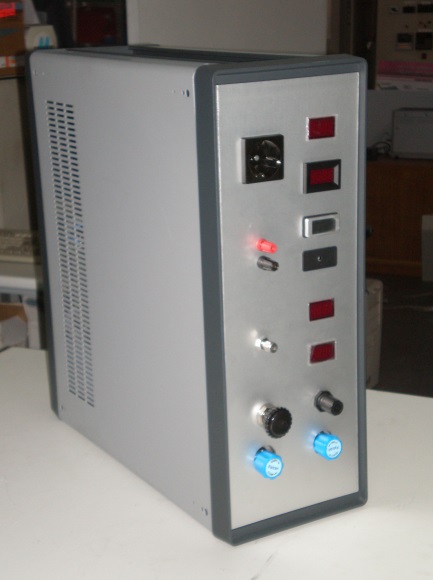
Auxiliar power system UPS-FC05
Power generation by integrating processor and fuel cell (PACO)
Design and construction of plants for biogas and conditioning of his power to a PEMFC fuel reforming. Fuel processing consists of a reforming step, followed by a water-gas shift and finally a preferential oxidation of CO. The contribution of heat to the process comes from a burner fed with slimes flue gas of the fuel cell and a variable portion of biogas from input. An analysis of the calorific powers in game shows how the main heat dissipation comes piping circuit design, while the energetically most important process is the evaporation of H2O required for water-gas shift reaction.
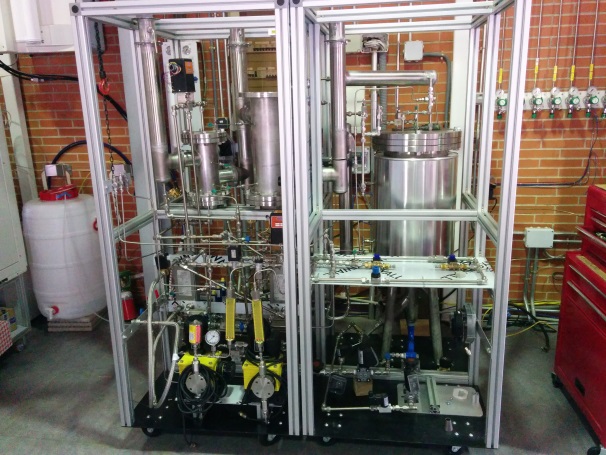
Fuel processor
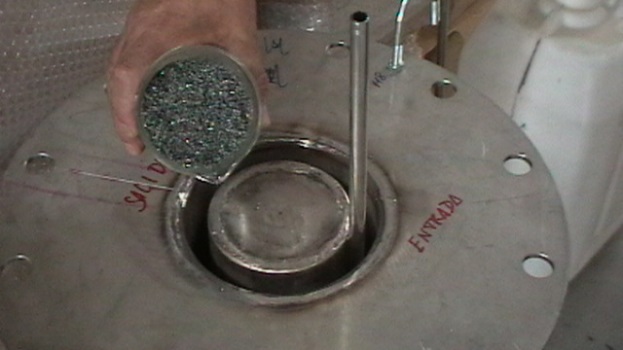
Catalyst addition to reforming vessel
Integration of a PEMFC in small vehicles
We are studying the hybridization of two electric small vehicles with a PEMFC. We have studied the behavior of the engine in various driving cycles and the various forms of integration of the PEMFC with batteries. Subsequently we will integrate both fuel cells and their hydrogen supply system based on several bottles for storage of hydrogen in metal hydride form. The fuel cell electrical output is conditioned to the power of the motors using the corresponding DC-DC converters that suited the tensions of fuel cells to that required by the engines.
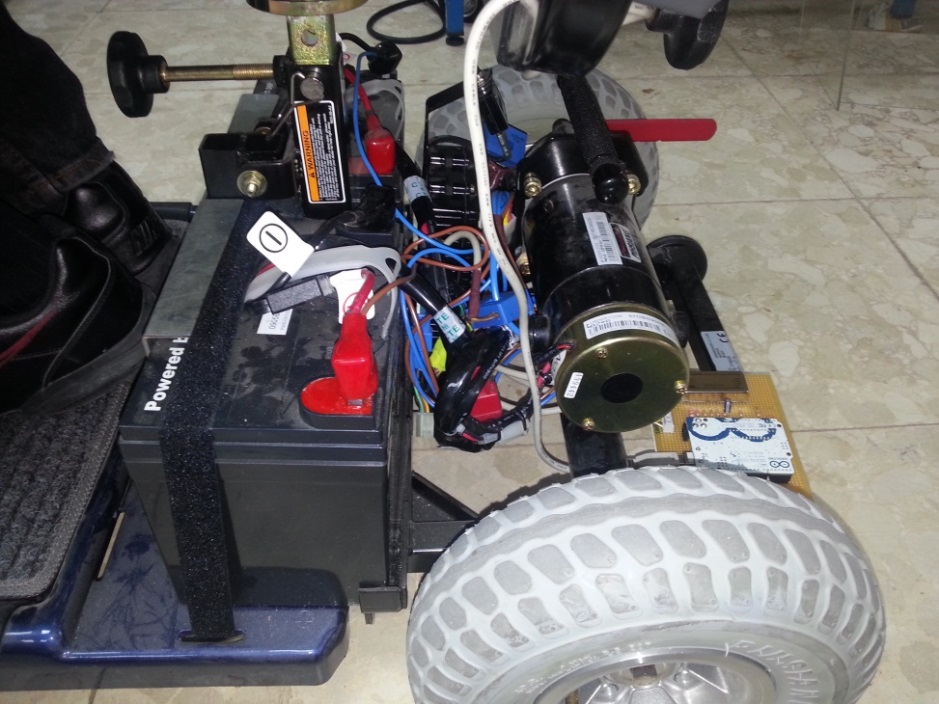
PIHSIANG electric Scooter
A fuel cell and its feeding system based on metal hydride bottles for the storage of hydrogen has been integrated in an electric wheelchair. The electrical output of the fuel cell is conditioned for powering the motors by means of a DC / DC converter that adapts the voltage of the fuel cell to that required by the motors. The heat generated by the fuel cell is used by redirecting it towards the storage bottles in order to facilitate the desorption of the hydrogen from the metal hydride. In addition, a system of control and monitoring of system variables has been implemented through a touch screen with which we can interact to connect or disconnect the fuel cell, see the status of the elements of the system and the remaining autonomy.
References
Generación de hidrógeno a partir de fuentes de energía renovables. T. González-Ayuso, M. Labrador, M.A. Folgado, J.L. Serrano, L. Daza. CONAPPICE2006. 237-240, October 2006.
GELSHI: Un sistema híbrido de generación de energía. T. González-Ayuso, M. Labrador, M.A. Folgado, J.L. Serrano, L. Daza. CONAPPICE2006, 301-304, October 2006.
Hydrogen management in APU hydrid system with fuel cell. T. González-Ayuso; M.A. Folgado; J.L. Serrano; J.L. Ortiz; A.M. Chaparro; L. Daza. WS-21: Hydrogen as a future energy carrier. Ávila, Spain, 2007.
Influence of the operation conditions on hydrogen production by electrolysis. T. González-Ayuso; M.A. Folgado; J.L. Serrano; A.M. Chaparro; L. Daza. WS-21: Hydrogen as a future energy carrier. Ávila, Spain, 2007.
Sistema autónomo de energía con pila de combustible. T. González-Ayuso, J.L. Serrano, F. Chenlo, J.L. Ortiz, L. Daza. CONAPPICE2008. ISBN 978-84-691-4415-2. 369-372. September 2008.
Unidad de potencia auxiliar (UPS) basada en pila de combustible. T. González-Ayuso, J.L. Serrano, J.L. Ortiz, M. Lambea, L. Daza. CONAPPICE2008. ISBN 978-84-691-4415-2. 399-402. September 2008.
Sistema para generación ininterrumpida de energía, basado en conversión fotovoltaica y pila de combustible. T. González-Ayuso; J.L. Serrano; A.M. Chaparro; M.A: Folgado; J.L. Ortiz; L. Daza. I Congreso de Generación Distribuida, GENEDIS 2009. Madrid, 2009
Development of the Energy Management System to control a Hybrid power generator. J.L. Serrano; T. González-Ayuso; A.M. Chaparro; J.L. Ortiz; L. Daza. 2009 Fuel Cell Seminar. Palm Springs, 2009.
Autonomous integrated system with solar energy and fuel cell. T. González-Ayuso; J.L. Serrano; A.M. Chaparro; J.L. Ortiz; L. Daza. 2009 Fuel Cell Seminar. Palm Springs, 2009.
Auxiliar power unit with increased auntonomy by means of a fuel cell system. T. González-Ayuso; J.L. Serrano; A.M. Chaparro; J.L. Ortiz; L. Daza. 2009 Fuel Cell Seminar, Palm Springs, 2009.
Operación de una PEMFC con gas de reformado. T. González-Ayuso; J. Pérez; M.A. Folgado; L. Daza. CONAPPICE 2010. Sevilla, Spain. 2010
Optimización de las condiciones de presión en una pila de combustible de membrana polimérica. B. Martínez Ruiz; J.L. Serrano; T. González Ayuso; L. Daza. CONAPPICE 2010, Sevilla,Spain, 2010.
Estrategias de control ante demanda variable de potencia para una planta de procesado de biogás acoplada a una pila de combustible polimérica. A.J. Martín; T. González Ayuso; M.A. Folgado; F. Daza; G. Muñoz; L. Daza. CONAPPICE 2010. Sevilla, Spain. 2010.
Diseño térmicamente eficiente mediante simulación de un sistema real de procesado de biogás acoplado a una pila de combustible de baja temperatura. A.J. Martín; T. González Ayuso; M.A. Folgado; F. Daza; G. Muñoz; L. Daza. CONAPPICE 2010. Sevilla,Spain. 2010.
Condiciones de llenado y vaciado de botellas de hidruros metálicos para la alimentación de una pila de combustible polimérica. J.L. Ortiz; J. Pérez; T. González Ayuso; L. Daza. CONAPPICE 2010. Sevilla, Spain. 2010.
Integration of a PEMFC in a UPS. J.L. Ortiz; F. Daza; T. González-Ayuso; L. Daza. 4th Edition of the European Fuel Cell Technology & Applications Piero Lunghi Conference. Rome, Italy. 2011.
Operation of biogas processing plant for electrical energy generation basen on dry reforming and low temperatura fuel cells. A.J. Martín; T. González-Ayuso; L. Daza. 4th edition of the European Fuel Cell Technology & Applications Piero Lunghi Conference. Rome, Italy. 2011.
Thermal analysis of a fuel cell by infrared thermography. J.A. Daza; A.J. Martín; A.M. Chaparro; T. González-Ayuso; L. Daza. 4th edition of the European Fuel Cell Technology & Applications Piero Lunghi Conference. Rome, Italy. 2011.
Influence of some critical operation parameters on the performance of a 5 m3-h-1 biogas processing plant for electricity generation based on dry reforming and low temperature fuel cells. A.J. Martín; T. González-Ayuso; L. Daza. 4th edition of the European Fuel Cell Technology & Applications Piero Lunghi Conference. Rome, Italy. 2011.
Analysis of a biogas processing plant coupling with a low temperature fuel cell. A.J. Martin; G. Muñoz; M.A. Folgado; J. Mielgo; L. Daza; T. González-Ayuso. 2011 Fuel Cell Seminar. Orlando, 2011.
Hybrid system based on fuel cell and hydrogen technology. B. Martínez Ruiz; T. González-Ayuso; L. Daza. 4th edition of the European Fuel Cell Technology & Applications Piero Lunghi Conference. Rome, Italy. 2011.
Operación de un procesador novedoso de biogás basado en reformado seco para producción de energía eléctrica mediante pilas de combustible. A.J. Martín; T. González Ayuso; J.L. Serrando; J. Mielgo; L. Daza. XXIII Congreso Iberoamericano de Catálisis. Santa Fe, Argentina. 2012.
Análisis de una microrred con generación de origen renovable e integración con pila de combustible de tipo PEM. B. Martínez Ruiz; J.L. Serrano; T. González-Ayuso; L. Daza. CONAPPICE 2012. Madrid, Spain. 2012.
Influencia de la composición del combustible en la operación de una PEMFC. T. González-Ayuso; F. Daza; L. Daza. CONAPPICE 2012. Madrid, Spain. 2012.
Operación de un procesador de combustible. T. González; A.J. Martín; J.L. Serrano; L. Daza. CONAPPICE 2012. Madrid, Spain. 2012,
Results analysis of a microgrid composed by photovoltaic generators and fuel cell. B. Martínez Ruiz, J.L. Serrano, T. González-Ayuso. European Fuel Cell - Piero Lunghi Conference & Exhibition 2013. Rome, Italy. December 2013.
A multi-fuel processor test bench based on reforming coupled to a fuel cell as a previous stage to industrial scale-up. A.J. Martín; T. González-Ayuso; C. Montoro; J.L. Serrano; J.A. Daza; A. Balbín; L. Daza. European Hydrogen Enegy Conference - EHEC 2014. Sevilla,Spain. 2014.
Control de operación de un electrolizador en un sistema integrado. T. González-Ayuso, J.L. Serrano, N. Santos. Congreso Iberoamericano de Hidrógeno y Pilas de Combustible Iberconappice 2014. Barcelona, Spain. 2014.
Hibridación de la impulsión de un scooter con una PEMFC. T. González-Ayuso, J.L. Serrano, L. Fernández Beites, D. Rodríguez. Congreso Iberoamericano de Hidrógeno y Pilas de Combustible Iberconappice 2014. Barcelona, Spain. 2014.
Simulación de la integración de una PEMFC en una vivienda. T. González-Ayuso, S. Soutullo. Congreso Iberoamericano de Hidrógeno y Pilas de Combustible Iberconappice 2014. Barcelona, Spain. 2014.
La termografía infrarroja cuantitativa como herramienta para estimación de temperaturas en sistemas complejos. J.A. Daza, M. Tejada, T. González Ayuso, L. Daza. Congreso Iberoamericano de Hidrógeno y Pilas de Combustible Iberconappice 2014. Barcelona, Spain. 2014.

